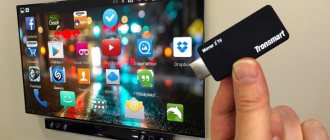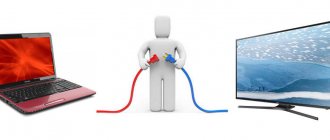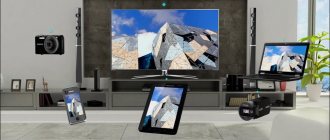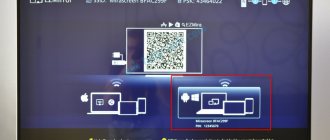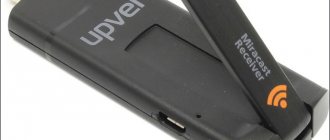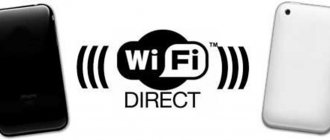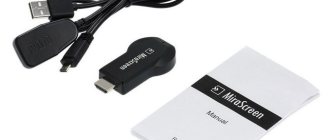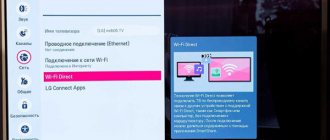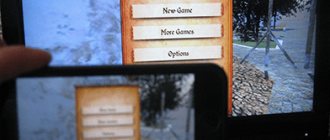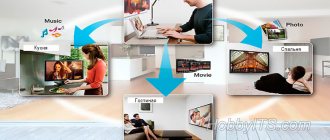As you know, on October 29, 2012, a new version of Google’s operating system, Android 4.2 Jelly Bean, was presented to the public. It was in this version that support for Miracast technology appeared - wireless transmission of videos and games to compatible TVs. Today I would like to talk about this technology. If you're part of the larger Android operating system community, you'll no doubt be interested in knowing how it works. Therefore, I ask, dear users of the best mobile portal, to go to the cat.
The best Telegram channel about technology (possibly)
What is Miracast
At its most basic level, Miracast technology is one of the Wi-Fi Alliance's wireless interface specifications - streaming. This allows the user to share whatever is displayed on the mobile device's display with another compatible product - such as a nearby TV. The specification supports resolutions up to 1920x1080 pixels, that is, FullHD. It is also worth noting support for 5.1 surround sound. Just imagine: you can download a movie to your own tablet through the Google Play store (or from the Internet, whatever), and later connect the tablet to the TV without any cords, cables, or loss of quality - incredibly convenient, no?
The beauty of Miracast technology is that it does not require any special equipment to operate. So unlike, say, wireless standards (like Wi-Fi 802.11n or Wi-Fi 802.11ac), you don't have to upgrade to a new device in order to use it. Specifically, Miracast is built on Wi-Fi Direct, which allows devices to use wireless networks to communicate with each other directly. Nowadays, many devices support Miracast technology. It makes transferring files and other things much easier. This technology is expected to become very popular in the future.
anycast adapter specifications
Anycast is a new version of adapters that help expand the functionality of TV using Wi-Fi. The device connects two devices via Wi-Fi and helps them pair. Externally, the device resembles a simple small flash drive. However, its connector goes for an HDMI output. The set includes a cord that allows you to connect the device to the network for proper operation. One end of the cable comes with an HDMI connector, and the other with a special button for switching modes.
The adapter has an ARM Cortex A9 1.6 GHz processor. Capable of playing various multimedia in HD format. Anycast consumes up to 750 mA. Due to its small dimensions and light weight, the adapter can be easily taken with you on vacation or on a trip, if you have the opportunity to connect it somewhere.
Similar services
Unlike the standard introduced by Apple (AirPlay), Miracast technology is completely open and can be used on any platform or device from various manufacturers that can equip their brainchild with support for this technology - even Apple, yes. Although, probably, more likely no than yes. Currently, there is a huge list of manufacturers that use Miracast technology. Among them: Intel, AMD, Broadcom, Ralink, NVIDIA, TI, Qualcomm, Marvell, MediaTek and others. Is it bad that so many famous companies have paid attention to this? No way.
Ultimately, however, the effect will be essentially the same - synergy between devices. This is one attempt to remove treacherous wires, confusing configurations and annoying interfaces from sharing multimedia content. Almost every device has two to five ways to “communicate” without any wires, right? WHY can't they just communicate with each other and everything will be much easier? This is the idea.
Did you know that Samsung also already has its own video streaming technology based on Miracast? It's called Samsung AllShare. Unfortunately, the software is limited only by the company's own brand, as well as a powerful hardware platform. For example, if you own a Samsung GALAXY S4 flagship or a Samsung GALAXY Tab Pro tablet, you can share content between either of them with relative ease.
It's also worth noting that the LG Nexus 4, LG Nexus 5, and Samsung Nexus 10 tablet all officially support Miracast out of the box. By the way, while Google claims that the Samsung Nexus 10 tablet can use it, this option is completely missing. Later it turned out that one of the Google representatives said that the problem would be fixed in the next updates for this model of the Google Nexus line. This option was also not available for the Samsung GALAXY Nexus smartphone and ASUS Nexus 7 tablet, which were updated to the then current version of the operating system - Android 4.2 Jelly Bean. This could probably be due to the lack of Miracast certification.
Connection algorithm
To connect the technology, you will first need to go into the internal settings of the TV. In this case, you need to make sure that the Wi-Fi router is activated. It is needed to initially launch the Miracast option.
If the wireless connection is not available, you will not be able to achieve the desired results.
- After synchronizing the TV with the router, you need to open the TV settings.
- In the parameters there is a “Devices” section, after going to which the nearest connected devices will become available.
- Next, you should add the required device yourself and click on Miracast activation.
In addition to activating the option on the TV, it is worth setting up the computer’s operating system. The device parameters must match, otherwise data transfer will not be possible. Miracast only works on both connected gadgets.
How it works
Miracast technology is based on Wi-Fi Direct, I already mentioned this earlier. Wi-Fi Direct was first introduced in Android 4.0 Ice Cream Sandwich. It allows users to create personal (Ad-Hoc) networks that other users can connect to and thereby share content. It was this that became the basis of Miracast.
With Wi-Fi Direct as its foundation, Miracast doesn't need to rely on your home's networks because it creates them itself. Your TV creates peer-to-peer networks that your smartphone or tablet discovers. The two devices are paired and data can be transferred between them completely freely.
In order to transmit the stream to the TV, Miracast technology uses the H.264 codec to display video in FullHD (1080p) format and 5.1 channel audio. For the technology to get to work, you need to have devices compatible with it - a smartphone or tablet, as well as a TV. If your device runs Android 4.2 Jelly Bean or later, you have Miracast support out of the box - it's called "Wireless Display" or "Wireless Monitor" in the settings menu.
Thus, you have created your own Miracast receiver. A number of different manufacturers, such as SONY, LG and Panasonic, integrate Miracast technology into branded TVs. If you do not have a modern TV model, you will need a so-called key. There is some competition in this regard, since the Amazon store offers Miracast dongles, but Best Buy also produces them under its own brand - Rocketfish. Most of these keys cost around $40-60.
Connect Miracast dongle. After that, you will need to go to the settings menu: Display > Wireless Monitor, and voila. Of course, the path may be slightly different depending on your mobile device. Now that you have activated the Wireless Display feature, the device will start searching for the Miracast dongle as well as the TV. When the corresponding list appears, connect, and after a few seconds you will see your image from your Android device on the TV screen. Now some people are thinking, “Isn’t this like a Chromecast?” - Not at all, and here's why:
With Miracast technology, your TV or dongle is completely dependent on the paired Android device. Therefore, for example, if your smartphone “falls asleep,” you will also see black on the TV screen. This interdependence is a big advantage, but just be sure to connect your smartphone or tablet to a charger.
In contrast, Google's technology, Chromecast, relies on the mobile device for only a moment during initial setup. However, this is precisely the reason why Chromecast technology is not nearly as dynamic as Miracast. It only works with compatible media apps and will not play DRM-protected content on your device.
Mirror iPhone and iPad screen to TV via MiraScreen adapter
Apple mobile devices and computers do not support Miracast. They have their own technology - AirPlay. At the moment, TVs do not have built-in AirPlay technology (I read that it may appear in new TVs from some manufacturers). But the Chinese somehow managed to implement AirPlay support in these MiraScreen and similar adapters.
This means our adapter is connected, turned on and configured. It must be connected to the same Wi-Fi network as our iPhone, or other device from which we will do a screen capture. If the adapter is not connected to the router, or there is no router, then you need to connect our iOS or Mac OS device directly to the Wi-Fi network of the adapter itself. Network name (SS>(see photo below).
The adapter must be switched to AirPlay mode (where the Apple icon is). I showed above how to connect, configure and switch the mode.
On an iPhone or iPad, open Control Center and select Screen Mirroring. If everything is connected correctly, then our MiraScreen set-top box should be displayed in the list of available devices. We just select it.
Let's come to the end
To be honest, perhaps in a few years this technology will simply be forgotten and fade into oblivion. On the other hand, after two or three years, devices, smartphones, tablets and others may appear on the mobile market that support Miracast technology out of the box. At the same time, there's also likely to be a wider range of dongles available to add functionality to your TV or computer monitor.
In the meantime, if you have devices that support the above technology, I advise you to have fun. In general, she needs to be given some time, but we just need to wait. The technology has not yet reached its true potential, but this should be corrected over time.
How to set up Miracast on Android: conclusions
So, the instructions on how to set up Miracast on Android are very simple. You need to turn it on on your TV, on your smartphone and select the TV from the list. The technology works great, and problems are resolved just as easily. If the TV does not support the function, just install an external adapter. If the signal is slow, you can move the devices closer to each other. Sometimes, to connect or speed up, you need to restart your phone and TV and connect them after that.
I am very pleased with the technology and recommend it to everyone I know. Miracast turns your Android smartphone into a real media center. To do this, you need to figure out the connection once, after which it can be used everywhere.
How and from what to make a reliable handle for a shovel?
Mass production of shovel handles, as is typical in economic models focused solely on profit, constantly sacrifices quality and technological details of the process for the sake of quantity. Of course, everyone benefits if you buy a new shovel every season rather than every few years.
A shovel handle that is not made correctly will very quickly lose its necessary qualities, and, as usual, it will have to be brought to condition manually again and again. Until one day it simply cracks along its entire length or simply breaks. Therefore, today we will understand the mistakes of mass production that leave us without a shovel handle. And we’ll solve the problem: what and how to make a handle for a shovel yourself.
